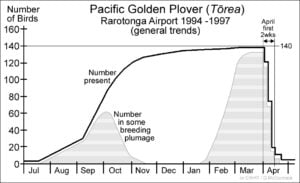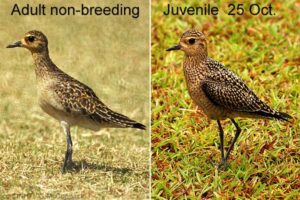Gerald McCormack, Natural Heritage Trust

During February and March the Pacific Golden-Plovers (Tōrea) transition from their dull non-breeding plumage into contrasting breeding plumage.
Holidaymakers gather in the airport departure lounge to leave for home, and as the boarding time approaches they hear entertainer Jake Numanga announce somewhat solemnly “Well, it’s time to go”. During February and March, Golden Plovers or Tōrea are also gathering around the airport grasslands to leave for home in Alaska. I wonder if they have a Jake bird announcing “Well, it’s time to go”?
Cook Islands Tōrea
During the Southern Summer, Pacific Golden-Plovers (Pluvialis fulva) are drab brown birds on open grassy areas and along the shoreline. They alternate between standing motionless and jogging a few metres, and periodically they peck at an insect or other invertebrate on the ground. When they take flight they often give a “tuuu-ree…..tuuu-ree” alarm call.
Traditional names for the plover imitate its alarm call: Tōrea (Rarotonga, Mangaia, Aitutaki, Manihiki, Rakahanga, Societies and Tuamotu), Toretōrea (Ātiu, Ma‘uke and Miti‘āro), Tuli (Penrhyn, Pukapuka, Nassau and Samoa), To‘ea (Marquesas), and Tusiik, Turiik or Tullik (Eskimo Alaska).
In the 1990s Natural Heritage recorded their comings and goings and their plumage on the airport grasslands (see graph). From May to early July there were a mere five plovers on the airport. Birds still in their Alaskan breeding plumage started to arrive around mid-July and there were a number of disputes over territories of grass beside the runway. There was a great increase in arrivals in August and September, and by the end of October there were about 120 birds all having moulted into dull non-breeding plumage. Most were the sole occupants of large grassed territories.

During the 1990s we found that plovers arrived mainly in September and October, and they departed in the first two weeks of April.
In February and March they transitioned back into their more dramatic breeding plumage. Around the end of March they were seen flying in groups around the airport area; in the first two weeks of April they left from the airport. Why the airport?
Did they need Jake to tell them “Well, it’s time to go”, or did they need flight information from the control tower? Probably neither. It is just that most Rarotonga plovers live on the airport grasslands and most of those living on grassed areas elsewhere on the island go to the airport at night for better protection from nocturnal predators. Most plovers know the airport area and it makes an ideal open space to gather before departure.
Migration routes
It has long been assumed that plovers migrate directly north-south to and from Alaska. And this was proven for the Kōlea that spend the northern winter in Hawai‘i. In 1996 twenty Kōlea carried tiny radio transmitters to Alaska and back to Hawai‘i1. They took about three days going north to Alaska and about four days returning south to Hawai‘i. (See the map.)
The idea that plovers from our area migrate directly north to Alaska was quashed in 2012 with a report on the journey of nineteen birds leaving Samoa with radio transmitters in early April 20102.

Research on Samoan plovers in 2012 showed they flew to Japan before going to Alaska. See text for details.
Instead of flying due north they flew northwest for six days and landed in central Japan around the rice fields where they gorged themselves for three weeks on insects and other invertebrates. They then flew northeast for three days to their breeding grounds in western Alaska around mid-May when spring had arrived and there was an abundance of insect life, fruits and berries.
In Alaska
The plovers fly into the high tundra-covered hills. Most males return to the same breeding territory they used the previous year where they perform aerial displays to attract a new mate. If all goes well the female lays four eggs in a moss and lichen nest on the ground. Twenty-five days later the young emerge and within a few hours they are running around with their parents learning about local foods and how to avoid foxes and predatory birds.
At three to four weeks of age the young are able to fly and the parents sneak away to the coast to fatten themselves for the long journey ahead. In mid-July, but especially in August and September, they leave Alaska to migrate southward to their tropical “wintering” grounds.
The closest tropical “wintering” grounds are the Hawaiian islands, a four-day flight, while those returning to our area have a 9,000km 7-day flight ahead. Plovers are not seabirds, they cannot feed at sea nor rest on the water. They must fly non-stop over the ocean. They can take a break on islands en route although the evidence indicates most do the whole journey non-stop.
In early September the young plovers notice the falling temperatures and diminishing food in the high country and they fly south to the richer feeding areas along the coast. Around the third week of September they depart southward on their first non-stop transoceanic flight.
The nearest land is Hawai‘i, about 4,000km or four days flying. We also know that at least some of these young birds continue south to other islands because we have some arriving in the Cook Islands around mid-October. How to they find our islands? How do they know there are no more islands to the south? How many die at sea on their first overseas flight?
A Female Tōrea itinerary
7th April: depart Rarotonga airport in small groups on six day flight to central Japanese rice fields. Enjoy local cuisine with plovers from other South Pacific countries and Micronesia for about three weeks.
7th May: depart Japan on 4-day flight to western Alaska. Upon arrival, fly around the inland mountains flirting with the dashing males who will be in the same territories as last year.
20th May or thereabouts: settle down with mate to build a nest and lay four eggs. Share incubation duties for four weeks with eggs hatching around mid-June. Run around with the children for nearly four weeks teaching them about food and how to avoid foxes and predatory birds.
15th July: leave the kids to their own devices and fly to the Alaskan coast to fatten up for the long flight ahead.
15th August: depart Alaska and fly due south.
23rd August: arrive Rarotonga and go to the same grassed area as before going to Alaska. Throw out any earlier usurper.
Moult into drab plumage, forget about long flights and kids for a few months, well, until black feathers start re-appearing next February. With luck each adult will undertake this itinerary about ten times.
“Well, it’s time to go.”
Citation
McCormack, Gerald (2021) Golden Plover migration to Alaska. https://cinature.org/2021/01/12/golden-plover-migration-to-alaska/
The author has published numerous articles on the Golden Plover migration. However all those up to 2012 were based on earlier speculation that the flight path to Alaska was directly northward. In mid-2012 tracking data showed South Pacific birds fly to Japan before going to Alaska. This was included in CI News articles of March 2017 and March 2019 (presented here with minor updates).
- Johnson et al. (1997) Migration by radio-tagged Pacific Golden-Plovers from Hawaii to Alaska, and their subsequent survival. Auk 114:521–524. [↩]
- Johnson et al. (2012) New insight concerning trans-oceanic migratory pathways of Pacific Golden-Plovers (Pluvialis fulva): the Japan stopover and other linkages as revealed by geolocators. Wader Study Group Bulletin 119(1): 1–8. [↩]
















